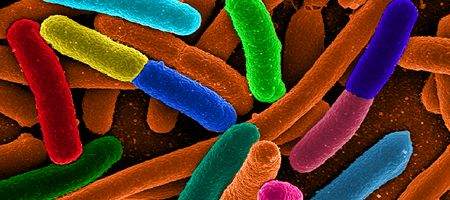MIT and Harvard researchers say they can edit the genetic code of a living cell, allowing them to give cells new functions such as building proteins not found in nature, or engineering bacteria that are resistant to any viral infection.

The technology can overwrite specific DNA sequences throughout the genome – just like the find-and-replace function in word-processing programs. The team was able to make hundreds of targeted edits to the genome of E. coli, apparently without disrupting the cells’ function.
“We did get some skepticism from biologists early on,” says MIT’s Peter Carr. “When you’re making so many intentional changes to the genome, you might think something’s got to go wrong with that.”
Nearly all living cells use the same genetic code, which has 64 codons, or three-letter DNA ‘words.’ While most specify an amino acid, some tell the cell when to stop adding amino acids to a protein chain. The MIT and Harvard researchers targeted one of these ‘stop’ codons, which consists of the letters TAG.
To make their edits, the researchers first used their existing multiplex automated genome engineering (MAGE) system to replace the TAG codon with another stop codon, TAA, in living E. coli cells. To make the process more manageable, they first used MAGE to engineer 32 strains of E. coli, each of which had 10 TAG codons replaced.
To combine those strains and eventually end up with one that has all 314 edits, the researchers then developed a new technology, conjugative assembly genome engineering (CAGE), which precisely controls a naturally occurring process that bacteria use to exchange genetic material. One bacterium builds an extension to a neighboring cell, then passes a piece of genetic material — in this case, TAA codons — to its neighbor.
The researchers set up a playoff-like system in which each strain shares its DNA with one other strain. After a couple of iterations, the researchers had four strains, each with about a quarter of the possible TAG substitutions. They believe they are on track to produce the single combined strain with all 314 of the substitutions.
Once all the TAG stop codons are deleted, the researchers’ next step is to delete the cell machinery that reads the TAG codon — freeing it up for a completely new purpose, such as encoding a novel amino acid. That kind of ‘plug-and-play’ slot would give scientists great flexibility in designing cells that produce new proteins, Carr says.
By altering the genetic code, scientists could also engineer bacteria that are resistant to multiple viruses – useful in the pharmaceutical and energy industries, where viruses affect up to 20 percent of cultures. However, those viruses can only infect a cell if the bacterial and viral genetic codes are the same.
Altering the genetic code of industrial bacteria could also create a ‘genetic firewall’ that would prevent engineered bacteria from spreading their genes to natural bacteria in the environment, or from allowing such bacteria to survive in the wild, Carr says.






